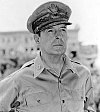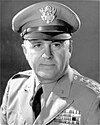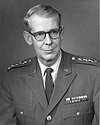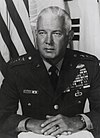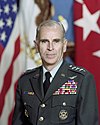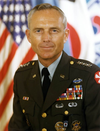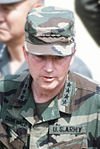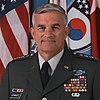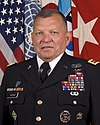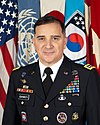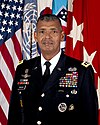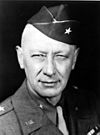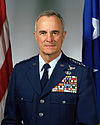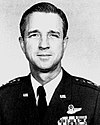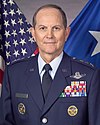United Nations Command
| United Nations Command | |
|---|---|
| 유엔군사령부 | |
 | |
| Active | 24 July 1950 – present (74 years, 4 months) |
| Allegiance | |
| Engagements | Korean War (1950–1953) |
| Website | www |
| Commanders | |
| Commander UNC/CFC/USFK | Gen. Paul J. LaCamera (US Army) |
| Deputy Commander | Lt. Gen. Derek A. Macaulay (Canadian Army) |
| Notable commanders | |
| Insignia | |
| Flag |  |
| Part of a series on |
| North Korea and the United Nations |
|---|
  |

United Nations Command (UNC or UN Command)[1] is the multinational military force established to support the Republic of Korea (South Korea) during and after the Korean War. It was the first international unified command in history, and the first attempt at collective security pursuant to the Charter of the United Nations.[1]
The UNC was established on 24 July 1950 following the United Nations Security Council's recognition, on 7 July, of North Korean aggression against South Korea. The motion passed because the Soviet Union, a close ally of North Korea and a member of the UN Security Council, was boycotting the UN at the time over its recognition of the Republic of China (Taiwan) rather than the People's Republic of China.[2] UN member states were called to provide assistance in repelling the North's invasion, with the UNC providing a cohesive command structure under which the disparate forces would operate.[3] During the course of the war, 22 nations contributed military or medical personnel to UN Command;[1] although the United States led the UNC and provided the bulk of its troops and funding, all participants formally fought under the auspices of the UN,[4] with the operation classified as a "UN-led police action".[5]
On 27 July 1953, United Nations Command, the Korean People's Army, and the Chinese People's Volunteers signed the Korean Armistice Agreement, ending open hostilities. The agreement established the Military Armistice Commission (MAC), consisting of representatives of the signatories, to supervise the implementation of the armistice terms, and the Neutral Nations Supervisory Commission (NNSC), composed of nations that did not participate in the conflict, to monitor the armistice's restrictions on the parties' reinforcing or rearming themselves.[Note 1][6] In 1975, the UN General Assembly adopted resolution 3390 (XXX), which called upon the parties to the Armistice Agreement to replace it with a peace agreement, and expressed the hope that UNC would be dissolved on 1 January 1976.[7] But the UNC continues to function after that.[8]
Since 1953, UNC's primary duties have been to maintain the armistice and facilitate diplomacy between North and South Korea.[9] Although "MAC" meetings have not occurred since 1994, UN Command representatives routinely engage members of the Korean People's Army in formal and informal meetings. The most recent formal negotiations on the terms of Armistice occurred between October and November 2018. Duty officers from both sides of the Joint Security Area (commonly known as the Truce Village of Panmunjom) conduct daily communications checks and have the ability to engage face-to-face when the situation demands.[10]
Origin and legal status
[edit]This section needs additional citations for verification. (February 2024) |
United Nations Command operates under the mandates of United Nations Security Council (UNSC) Resolutions 82, 83, 84, and 85. These passed while the Soviet Union was boycotting the UN for awarding China's seat in the Security Council to the Republic of China.[2] While the UN had some military authority through Chapter VII of the United Nations Charter, early Cold War tensions meant that the forces envisaged in those articles had yet to become reality. Thus the UN had little practical ability to raise a military force in response to the North Korean invasion of the South. Consequently, the UNSC designated the United States as the executive agent for leading a "unified command" under the UN flag. As it was a designated body, the UN exercised little control over the combat forces. This represented the first attempt at collective security under the UN system.
When the warring parties signed the Korean Armistice Agreement on 27 July 1953, the commander delivered the Agreement to the UN. In August 1953, the UN General Assembly passed a resolution “noting with approval” the Armistice Agreement, a step that was critical for the UN to take the next step of organizing the 1954 Geneva Conference meant to negotiate a diplomatic peace between North and South Korea. The adoption of the Korean Armistice Agreement in the UN General Assembly underwrites UN Command's current role of maintaining and enforcing the Armistice Agreement.
The role of the United States as the executive agent for the unified command has led to questions over its continued validity. Most notably, in 1994, UN Secretary General Boutros Boutros-Ghali wrote in a letter to the North Korean Foreign Minister that:
the Security Council did not establish the unified command as a subsidiary organ under its control, but merely recommended the creation of such a command, specifying that it be under the authority of the United States. Therefore, the dissolution of the unified command does not fall within the responsibility of any United Nations organ but is a matter within the competence of the Government of the United States.[11]
The UN's official position is that the Korean War-era Security Council and General Assembly resolutions remain in force. This was evidenced in 2013 when North Korea announced unilateral abrogation of the Armistice Agreement: UN spokesman Martin Nesirky asserted that since the Armistice Agreement had been adopted by the General Assembly, no single party could dissolve it unilaterally. The UNC continues to serve as the signatory and party of the Armistice opposite the Korean People's Army.
In JENNINGS v. MARKLEY, WARDEN, a determination was made by the Court of Appeals Seventh Circuit that American soldiers of the UNC were still liable to the Uniform Code of Military Justice although they fought under the UN blue flag.[12]
Establishment in 1950
[edit]After troops of North Korea invaded South Korea on 25 June 1950, the United Nations Security Council adopted Resolution 82 calling on North Korea to cease hostilities and withdraw to the 38th parallel.[13]
Two days later, the UNSC adopted Resolution 83, recommending that members of the United Nations provide assistance to the Republic of Korea "to repel the armed attack and to restore international peace and security to the area".[14]
The first non-Korean and non-U.S. unit to see combat was the No. 77 Squadron of the Royal Australian Air Force, which began escort, patrol and ground attack sorties from Iwakuni Royal Australian Air Base, Japan on 2 July 1950. On 29 June 1950, New Zealand made preparations to dispatch two Loch class frigates, Tutira and Pukaki, to Korean waters;[15] on 3 July, the ships left Devonport Naval Base, Auckland and joined other Commonwealth forces at Sasebo, Japan on 2 August. For the duration of the war, at least two NZ vessels would be on station in the theater.
Resolution 84, adopted on 7 July 1950, recommended that members providing military forces and other assistance to South Korea "make such forces and other assistance available to a unified command under the United States of America".[16]
President Syngman Rhee of the Republic of Korea assigned operational command of ROK ground, sea, and air forces to General MacArthur as Commander-in-Chief UN Command (CINCUNC) on 15 July 1950:
In view of the common military effort of the United Nations on behalf of the Republic of Korea, in which all military forces, land, sea and air, of all the United Nations fighting in or near Korea have been placed under your operational command, and in which you have been designated Supreme Commander United Nations Forces, I am happy to assign to you command authority over all land, sea, and air forces of the Republic of Korea during the period of the continuation of the present state of hostilities, such command to be exercised either by you personally or by such military commander or commanders to whom you may delegate the exercise of this authority within Korea or in adjacent seas.[17]
On 29 August 1950, the British Commonwealth's 27th Infantry Brigade arrived at Busan to join UNC ground forces, which until then included only ROK and U.S. forces. The 27th Brigade moved into the Naktong River line west of Daegu.
Units from other countries of the UN followed: the Belgian United Nations Command, the 25th Canadian Infantry Brigade, the Colombian Battalion,[18] the Ethiopian Kagnew Battalion, the French Battalion, the Greek 15th Infantry Regiment, New Zealand's 16th Field Regiment and Royal New Zealand Artillery, the Philippine Expeditionary Forces to Korea, the South African No. 2 Squadron SAAF, the Turkish Brigade, and forces from Luxembourg and the Netherlands. Additionally, Denmark, India, Iran, Norway and Sweden provided medical units; Italy provided a hospital, even though it was not a UN member at the time.
By 1 September 1950, less than two months before the formation of United Nations Command, these combined forces numbered 180,000, of which 92,000 were South Koreans, with most of the remainder being Americans, followed by the 1,600-man British 27th Infantry Brigade.
Rockoff writes that "President Truman responded quickly to the June invasion by authorizing the use of U.S. troops and ordering air strikes and a naval blockade. He did not, however, seek a declaration of war, or call for full mobilization, in part because such actions might have been misinterpreted by Russia and China. Instead, on July 19 he called for partial mobilization and asked Congress for an appropriation of $10 billion for the war."[19] Cohen writes that: "All of Truman's advisers saw the events in Korea as a test of American will to resist Soviet attempts to expand their power, and their system. The United States ordered warships to the Taiwan Strait to prevent Mao's forces from invading Taiwan and mopping up the remnants of Chiang Kai-shek's army there."[20]
As of 1 July 1957 the commander of the United Nations Command was "triple hatted" being given command the United States Forces Korea and Eighth United States Army in addition to the UN command. The first commander to be "triple hatted" in this way was General George Decker, who would later serve as the Chief of Staff of the United States Army.
Commander
[edit]| No. | Commander | Term | Service branch | |||
|---|---|---|---|---|---|---|
| Portrait | Name | Took office | Left office | Term length | ||
| 1 | General of the Army Douglas MacArthur (1880–1964) | 7 July 1950 | 11 April 1951 | 278 days |  U.S. Army | |
| 2 | General Matthew Ridgway (1895–1993) | 11 April 1951 | 12 May 1952 | 1 year, 31 days |  U.S. Army | |
| 3 | General Mark W. Clark (1896–1984) | 12 May 1952 | 7 October 1953 | 1 year, 148 days |  U.S. Army | |
| 4 | General John E. Hull (1895–1975) | 7 October 1953 | 1 April 1955 | 1 year, 176 days |  U.S. Army | |
| 5 | General Maxwell D. Taylor (1901–1987) | 1 April 1955 | 5 June 1955 | 65 days |  U.S. Army | |
| 6 | General Lyman Lemnitzer (1899–1988) | 5 June 1955 | 1 July 1957 | 2 years, 26 days |  U.S. Army | |
| 7 | General George Decker (1902–1980) | 1 July 1957 | 30 June 1959 | 1 year, 364 days |  U.S. Army | |
| 8 | General Carter B. Magruder (1900–1988) | 1 July 1959 | 30 June 1961 | 1 year, 364 days |  U.S. Army | |
| 9 | General Guy S. Meloy (1903–1968) | 1 July 1961 | 31 July 1963 | 2 years, 30 days |  U.S. Army | |
| 10 | General Hamilton H. Howze (1908–1998) | 1 August 1963 | 15 June 1965 | 1 year, 318 days |  U.S. Army | |
| 11 | General Dwight E. Beach (1908–2000) | 16 June 1965 | 31 August 1966 | 1 year, 76 days |  U.S. Army | |
| 12 | General Charles H. Bonesteel III (1909–1977) | 1 September 1966 | 30 September 1969 | 3 years, 29 days |  U.S. Army | |
| 13 | General John H. Michaelis (1912–1985) | 1 October 1969 | 31 August 1972 | 2 years, 335 days |  U.S. Army | |
| 14 | General Donald V. Bennett (1915–2005) | 1 September 1972 | 31 July 1973 | 333 days |  U.S. Army | |
| 15 | General Richard G. Stilwell (1917–1991) | 1 August 1973 | 8 October 1976 | 3 years, 68 days |  U.S. Army | |
| 16 | General John W. Vessey Jr. (1922–2016) | 8 October 1976 | 10 July 1979 | 2 years, 275 days |  U.S. Army | |
| 17 | General John A. Wickham Jr. (1928–2024) | 10 July 1979 | 4 June 1982 | 2 years, 329 days |  U.S. Army | |
| 18 | General Robert W. Sennewald (1929–2023) | 4 June 1982 | 1 June 1984 | 1 year, 363 days |  U.S. Army | |
| 19 | General William J. Livsey (1931–2016) | 1 June 1984 | 25 June 1987 | 3 years, 24 days |  U.S. Army | |
| 20 | General Louis C. Menetrey Jr. (1929–2009) | 25 June 1987 | 26 June 1990 | 3 years, 1 day |  U.S. Army | |
| 21 | General Robert W. RisCassi (born 1936) | 26 June 1990 | 15 June 1993 | 2 years, 354 days |  U.S. Army | |
| 22 | General Gary E. Luck (born 1937) | 15 June 1993 | 9 July 1996 | 3 years, 24 days |  U.S. Army | |
| 23 | General John H. Tilelli Jr. (born 1941) | 9 July 1996 | 9 December 1999 | 3 years, 153 days |  U.S. Army | |
| 24 | General Thomas A. Schwartz (born 1945) | 9 December 1999 | 1 May 2002 | 2 years, 143 days |  U.S. Army | |
| 25 | General Leon J. LaPorte (born 1946) | 1 May 2002 | 3 February 2006 | 3 years, 278 days |  U.S. Army | |
| 26 | General B.B. Bell (born 1947) | 3 February 2006 | 3 June 2008 | 2 years, 121 days |  U.S. Army | |
| 27 | General Walter L. Sharp (born 1952) | 3 June 2008 | 14 July 2011 | 3 years, 41 days |  U.S. Army | |
| 28 | General James D. Thurman (born 1953) | 14 July 2011 | 12 October 2013 | 2 years, 80 days |  U.S. Army | |
| 29 | General Curtis M. Scaparrotti (born 1956) | 2 October 2013 | 30 April 2016 | 2 years, 211 days |  U.S. Army | |
| 30 | General Vincent K. Brooks (born 1958) | 30 April 2016 | 8 November 2018 | 2 years, 192 days |  U.S. Army | |
| 31 | General Robert B. Abrams (born 1960) | 8 November 2018 | 2 July 2021 | 2 years, 236 days |  U.S. Army | |
| 32 | General Paul LaCamera (born 1963) | 2 July 2021 | Incumbent | 3 years, 143 days |  U.S. Army | |
Deputy Commander
[edit]| No. | Deputy Commander | Term | Service branch | |||
|---|---|---|---|---|---|---|
| Portrait | Name | Took office | Left office | Term length | ||
| 1 | Lieutenant General John B. Coulter (1891–1983) | 7 July 1950 | 1952 | – |  U.S. Army | |
| 2 | Lieutenant General William Kelly Harrison Jr. (1895–1987) | 1952 | 1954 | – |  U.S. Army | |
| 3 | Lieutenant General Bruce C. Clarke (1901–1988) | 1954 | 1954 | – |  U.S. Army | |
| 4 | Lieutenant General Claude Birkett Ferenbaugh (1899–1975) | 10 December 1954 | 27 June 1955 | – |  U.S. Army | |
| 5 | Lieutenant General John Howell Collier (1898–1980) | 27 June 1955 | September 1955 | – |  U.S. Army | |
| 6 | Lieutenant General Charles D. Palmer (1902–1999) | September 1955 | 1958 | – |  U.S. Army | |
| 7 | Lieutenant General Emerson LeRoy Cummings (1902–1986) | December 1958 | January 1961 | – |  U.S. Army | |
| 8 | Lieutenant General Andrew T. McNamara (1905–2002) | January 1961 | 1 October 1961 | – |  U.S. Army | |
| 9 | Lieutenant General Samuel L. Myers (1905–1987) | 1 October 1961 | 31 March 1963 | – |  U.S. Army | |
| 10 | Lieutenant General Charles W. G. Rich (1909–1993) | 1964 | 1966 | – |  U.S. Army | |
| 11 | Lieutenant General Vernon P. Mock (1912–1983) | 1966 | February 1969 | – |  U.S. Army | |
| 12 | Lieutenant General John H. Michaelis (1912–1985) | February 1969 | 1 October 1969 | – |  U.S. Army | |
| 13 | Lieutenant General John A. Heintges (1912–1994) | 1969 | 22 May 1970 | – |  U.S. Army | |
| 14 | Lieutenant General Patrick F. Cassidy (1915–1990) | June 1970 | 14 September 1971 | – |  U.S. Army | |
| 15 | Lieutenant General William R. Peers (1914–1984) | 14 September 1971 | 1973 | – |  U.S. Army | |
| 16 | Lieutenant General Richard T. Knowles (1916–2013) | 1973 | July 1974 | – |  U.S. Army | |
| 17 | Lieutenant General Edward M. Flanagan, Jr. (1921–2019) | July 1974 | May 1975 | – |  U.S. Army | |
| 18 | Lieutenant General John J. Burns (1924–2000) | August 1975 | June 1977 | – |  U.S. Air Force | |
| 19 | Lieutenant General Charles A. Gabriel (1928–2003) | June 1977 | 1 April 1979 | – |  U.S. Air Force | |
| 20 | Lieutenant General Evan W. Rosencrans (1926–2007) | 1 April 1979 | 1 May 1981 | 2 years, 30 days |  U.S. Air Force | |
| 21 | Lieutenant General Winfield W. Scott Jr. (1927–2022) | 1 May 1981 | May 1983 | – |  U.S. Air Force | |
| 22 | Lieutenant General John L. Pickitt (1933–2020) | May 1983 | 20 April 1985 | – |  U.S. Air Force | |
| 23 | Lieutenant General Jack I. Gregory (born 1931) | 20 April 1985 | 9 December 1986 | 1 year, 233 days |  U.S. Air Force | |
| 24 | Lieutenant General Craven C. Rogers Jr. (1934–2016) | 9 December 1986 | 31 October 1988 | 1 year, 327 days |  U.S. Air Force | |
| 25 | Lieutenant General Thomas A. Baker (born 1935) | 31 October 1988 | 7 July 1990 | 1 year, 249 days |  U.S. Air Force | |
| 26 | Lieutenant General Ronald Fogleman (born 1942) | 7 July 1990 | 17 August 1992 | 2 years, 41 days |  U.S. Air Force | |
| 27 | Lieutenant General Howell M. Estes III (born 1941) | 17 August 1992 | 30 September 1994 | 2 years, 44 days |  U.S. Air Force | |
| 28 | Lieutenant General Ronald W. Iverson | 30 September 1994 | 7 April 1997 | 2 years, 189 days |  U.S. Air Force | |
| 29 | Lieutenant General Joseph E. Hurd | 7 April 1997 | 14 September 1999 | 2 years, 160 days |  U.S. Air Force | |
| 30 | Lieutenant General Charles R. Heflebower | 14 September 1999 | 19 November 2001 | 2 years, 66 days |  U.S. Air Force | |
| 31 | Lieutenant General Lance L. Smith (born 1946) | 19 November 2001 | 19 November 2003 | 2 years, 0 days |  U.S. Air Force | |
| 32 | Lieutenant General Garry R. Trexler (born 1947) | 19 November 2003 | 6 November 2006 | 2 years, 352 days |  U.S. Air Force | |
| 33 | Lieutenant General Stephen G. Wood (born 1949) | 6 November 2006 | 24 November 2008 | 2 years, 18 days |  U.S. Air Force | |
| 34 | Lieutenant General Jeffrey A. Remington (born 1955) | 24 November 2008 | 6 January 2012 | 3 years, 43 days |  U.S. Air Force | |
| 35 | Lieutenant General Jan-Marc Jouas | 6 January 2012 | 19 December 2014 | 2 years, 347 days |  U.S. Air Force | |
| 36 | Lieutenant General Terrence J. O'Shaughnessy (born 1962) | 19 December 2014 | 8 July 2016 | 1 year, 202 days |  U.S. Air Force | |
| 37 | Lieutenant General Thomas W. Bergeson (born 1962) | 8 July 2016 | 30 July 2018 | 2 years, 22 days |  U.S. Air Force | |
| 38 | Lieutenant-general Wayne Eyre (born 1968) | 30 July 2018 | 26 July 2019 | 361 days |  Canadian Army | |
| 39 | Vice admiral Stuart Mayer (born 1964) | 26 July 2019 | 15 December 2021 | 2 years, 142 days |  Royal Australian Navy | |
| 40 | Lieutenant General Andrew Harrison (born 1967) | 15 December 2021[21] | 14 December 2023 | 1 year, 364 days |  British Army | |
| 41 | Lieutenant-general Derek A. Macaulay | 14 December 2023[22] | Incumbent | 344 days |  Canadian Army | |
Current membership
[edit]- 18 countries, as of August 2024[23][24][25]
- Of the original 16 countries that provided combat troops during the Korean War, currently Ethiopia and Luxembourg are not members.
- Of the original 5 countries that provided medical support during the Korean War, currently Sweden and India are not members.
Contributing forces: 1950–1953
[edit]During the three years of the Korean War, the following nations were members of the UNC.[27] By 27 July 1953, the day the Armistice Agreement was signed, UNC had reached a peak strength of 932,964:
- South Korea
- 16 countries provided combat troops:
- 5 countries provided medical support and humanitarian aid:
During the course of the war, UNC was led by Douglas MacArthur, Matthew B. Ridgway, and Mark Wayne Clark. After the armistice was signed, John E. Hull was named UNC commander to carry out the ceasefire (including the voluntary repatriation of prisoners of war).[28]
Post Korean War (1953–present)
[edit]Following the signing of the Armistice Agreement, UNC remained in Korea to fulfill the functions of providing security and stability on the Peninsula, as well as supporting UN efforts to rebuild the war-torn Republic of Korea. Much of the fifties was marked by continuous negotiations in Military Armistice Commission meetings while the international community worked to bolster South Korea's economy and infrastructure. During this period, North Korea maintained economic and military superiority over its southern neighbor owing to Chinese and Soviet support.
The sixties proved a tenuous decade on the Korean Peninsula, punctuated by a period of hostilities between 1966 and 1969 that saw a heightened level of skirmishes in the DMZ as well as major incidents including North Korea's attempted assassination of South Korean leader Park Chung-hee and seizure of the USS Pueblo.
The seventies saw a brief period of rapprochement that later contributed to structural changes to UNC. In 1972, the North and South Korean governments signed a Joint Communique calling for more peaceful ties between the two Koreas. Concurrently, consecutive U.S. administrations (Nixon, Ford, and Carter) sought to decrease the South Korean reliance upon U.S. forces for maintaining deterrent capabilities on the Korean Peninsula. On 7 November 1978, a combined headquarters, the Republic of Korea – United States Combined Forces Command (CFC), was created, and the South Korean military units with front-line missions were transferred from the UN Command to the CFC's operational control. The commander-in-chief of the CFC, a United States military officer, answered ultimately to the national command authorities of the United States and that of South Korea.
From 1978, UNC maintained its primary functions of maintaining and enforcing the Korean Armistice Agreement, facilitating diplomacy that could support a lasting peace on the Peninsula, and providing a command that could facilitate multinational contributions should the armistice fail. UNC decreased in size, and over time, many of the billets assigned to UNC became multi-hatted with U.S. Forces Korea and Combined Forces Command.
The 1990s again saw notable change in UNC. In October 1991, UNC transferred responsibility of all DMZ sectors except for the Joint Security Area to the ROK military. In 1992, UNC appointed a South Korean General officer to serve as the Senior Member to the Military Armistice Commission. This led to the Korean People's Army and Chinese People's Volunteers boycotting MAC meetings. The collapse of the Soviet Union also led North Korea to question the alignment of their choices for the Neutral Nations Supervisory Commission. They no longer recognized Czech or Slovak representatives of Czechoslovakia when the nation split into the Czech Republic and Slovakia. In 1994, North Korea expelled the Polish delegation and also dismissed the Chinese People's Volunteers from the Panmunjom mission, owing in part to a protest over China's warming ties with South Korea.
Since 1998, UNC has seen a gradual increase of permanent international staff within the command. In between 1998 and 2003, several of the original contributors to the Korean War began deploying personnel to Korea to support UNC's armistice maintenance functions. This internationalization has continued over the next decades. In May 2018,[29] Canadian Lt. General Wayne Eyre became the first non-American to serve as deputy commander of the UNC.[29][30][31][32] Succeeding him was Australian Vice Admiral Stuart Mayer, and the Lieutenant General Andrew Harrison of the British Army, continuing the trend of non-American leadership in UNC.
UNC–Rear
[edit]United Nations Command–Rear is located at Yokota Air Base, Japan and is commanded by a Royal Australian Air Force group captain with a deputy commander from the Canadian Forces. Its task is to maintain the SOFA that permits the UNC to retain a logistics rear and staging link on Japanese soil.[33]
Future of the Joint Security Area
[edit]To further the September 2018 inter-Korean Comprehensive Military Agreement, UN Command, Republic of Korea Armed Forces, and North Korean People's Army officials met in a series of negotiations to deliberate the demilitarization of the Joint Security Area.[34] The first two meetings in October led to Demining activities within the JSA, de-arming of personnel, and sealing off of Guard Posts.[35] On 6 November 2018, UNC conducted a third round of negotiations with the South Korean military and North Korean People's Army on "Rules of Interaction" which would underwrite a Joint Security Area where both sides of the Military Demarcation Line—the de facto border—would be open to personnel. For undisclosed reasons, the North Korean side refused to meet to finalize these rules and the next step for realizing a demilitarized Joint Security Area. Regardless of past compromises, North Korea began to arm their soldiers in the JSA with pistols around the end of November 2023.[36]
See also
[edit]- United Nations Forces in the Korean War
- Medical support in the Korean War
- United Nations Memorial Cemetery in Busan, where 2,300 casualties from various nations are buried
- U.S. Far East Command
- Free World Military Assistance Forces
Notes
[edit]- ^ The North Korean-Chinese MAC was replaced by the "Panmunjom Mission" under exclusive North Korean administration.
References
[edit]- ^ a b c "United Nations Command > History > 1950–1953: Korean War (Active Conflict)". www.unc.mil. Retrieved 5 November 2020.
- ^ a b "United Nations Security Council - History". Encyclopedia Britannica. 29 October 2024. Retrieved 29 October 2024.
- ^ "United Nations Command > History > 1950–1953: Korean War (Active Conflict)". www.unc.mil. Retrieved 5 November 2020.
- ^ "United Nations Command > Resources > FAQs". www.unc.mil. Retrieved 6 November 2020.
- ^ "The United Nations in Korea | Harry S. Truman". www.trumanlibrary.gov. Retrieved 6 November 2020.
- ^ "State Department message to DPRK". Archived from the original on 31 August 2000. Retrieved 29 November 2006.
- ^ "Question of Korea". United Nations Digital Library. 1976. Retrieved 27 February 2021.
- ^ Salmon, Andrew (8 May 2019). "In South Korea, a UN Command that isn't". Asia Times. Retrieved 10 April 2021.
- ^ "Let the UN Command Remain a Tool for Korean Peace". Council on Foreign Relations. Retrieved 6 November 2020.
- ^ "Joint Security Area / Panmunjom". Retrieved 9 April 2006.
- ^ Pak Chol Gu (7 May 1997). "Replacement of the Korean Armistice Agreement: Prerequisite to a lasting peace in the Korean Peninsula". Nautilus Institute. Retrieved 2 May 2013.
UN Secretary General Boutros Boutros Ghali noted in his letter to the Foreign Minister of the DPRK, dated 24 June 1994: I do not believe, though, that any principal organ of the United Nations, including the Secretary General, can be the proper instance to decide on the continued existence or the dissolution of the United Nations Command. However, allow me to recall that the Security Council, in operative paragraph 3 of resolution 84 (1950) of 7 July 1950, limited itself to recommending that all members providing military forces and other assistance to the Republic of Korea 'make such forces and other assistance available to a unified command under the United States of America'. It follows, accordingly, that the Security Council did not establish the unified command as a subsidiary organ under its control, but merely recommended the creation of such a command, specifying that it be under the authority of the United States. Therefore, the dissolution of the unified command does not fall within the responsibility of any United Nations organ but is a matter within the competence of the Government of the United States.
- ^ "Jennings v . Markley, Warden". International Law Reports. 32: 367–368. 1966. doi:10.1017/CBO9781316151594.110. S2CID 248997335.
- ^ "United Nations Security Council Resolution 82" (PDF). 25 June 1950. Retrieved 4 March 2016.
- ^ "United Nations Security Council Resolution 83" (PDF). 27 June 1950. Retrieved 4 March 2016.
- ^ Korean Scholarships – Navy Today, Defence Public Relations Unit, Issue 133, 8 June, Page 14-15
- ^ "United Nations Security Council Resolution 84" (PDF). 7 July 1950. pp. 1–2. Retrieved 4 March 2016.
- ^ Kyung Y. Chung (1989). Analysis of ROK-US Military Command Relationship from the Korean War to the Present (PDF) (master thesis). Fort Leavenworth, Kansas: United States Army Command and General Staff College. p. 7. ISBN 978-1249403975. OCLC 939481483. Archived (PDF) from the original on 17 October 2021. citing James P Finley (1983). The US military experience in Korea, 1871-1982 : in the vanguard of ROK-US relations. San Francisco: Command Historian's Office, Secretary Joint Staff, Hqs., USFK/EUSA. p. 59. OCLC 10467350.
- ^ Coleman, Bradley Lynn (October 2005). "The Colombian Army in Korea, 1950–1954" (PDF). The Journal of Military History. 69 (4). Project Muse (Society for Military History): 1137–1177. doi:10.1353/jmh.2005.0215. ISSN 0899-3718. S2CID 159487629.
- ^ "The Korean War". Drastic Measures. 1984. pp. 177–199. doi:10.1017/CBO9780511600999.008. ISBN 978-0-521-24496-1.
- ^ "The Korean War and Its Consequences". The New Cambridge History of American Foreign Relations. 2013. pp. 58–78. doi:10.1017/CHO9781139032513.006. ISBN 978-1-139-03251-3.
- ^ "No. 63576". The London Gazette (Supplement). 4 January 2021. p. 23984.
- ^ "Canadian 3-star general takes office as new deputy UNC chief". United Nations Command. 14 December 2023. Retrieved 1 January 2024.
- ^ 뉴스TVCHOSUN (6 July 2023). [단독] 文정부, '6·25지원국' 덴마크에 '유엔사 제외' 일방통보. Retrieved 29 October 2024 – via YouTube.
- ^ 국방부 "6·25 기여 형태와 무관하게 회원국의 유엔사 참여 가능"
- ^ "[ 단독 ] 美, 유엔사 재활성화 '동아시아판 나토' 만든다". n.news.naver.com (in Korean). Retrieved 29 October 2024.
- ^ "Germany joins US-led UN Command in South Korea policing armistice border". The Times of India. 2 August 2024. ISSN 0971-8257. Retrieved 29 October 2024.
- ^ "United Nations Command". Archived from the original on 12 March 2013. Retrieved 27 June 2011.
- ^ Paul M. Edwards (10 June 2010). Historical Dictionary of the Korean War. Scarecrow Press. p. 129. ISBN 978-0-8108-7461-9.
- ^ a b "UN Command names Canadian to key post in South Korea for the first time". The Globe and Mail. 13 May 2018. Retrieved 18 July 2019.
- ^ Pinkerton, Charlie (5 November 2018). "Canadians at centre of 'potentially historic turning point' in Korea – iPolitics". Ipolitics.ca. Retrieved 18 July 2019.
- ^ "Deputy Commander UNC > United States Forces Korea > Article View". Usfk.mil. 1 May 2015. Archived from the original on 6 November 2018. Retrieved 18 July 2019.
- ^ "Can United Nations Command become catalyst for change in the Korean peninsula?". National Interest. November 2018. Retrieved 18 July 2019.
- ^ "Fact Sheet" (PDF). 22 December 2015. Retrieved 27 March 2018.
- ^ "UNC, ROK, DPRK Conduct Historic Trilateral Meeting 유엔사 및 남북한은 역사적인 3자회의 개최". United States Forces Korea. Retrieved 26 March 2024.
- ^ Jun-suk, Yeo (16 October 2018). "Two Koreas, UNC hold first trilateral talks to disarm JSA". The Korea Herald. Retrieved 26 March 2024.
- ^ Eun-jung, Kim (28 November 2023). "(LEAD) N. Korean soldiers in truce village armed with pistols: sources". Yonhap News Agency. Retrieved 26 March 2024.
Further reading
[edit]- Grey, Jeffrey. The Commonwealth Armies and the Korean War: An Alliance Study. Manchester University Press, 1990.

